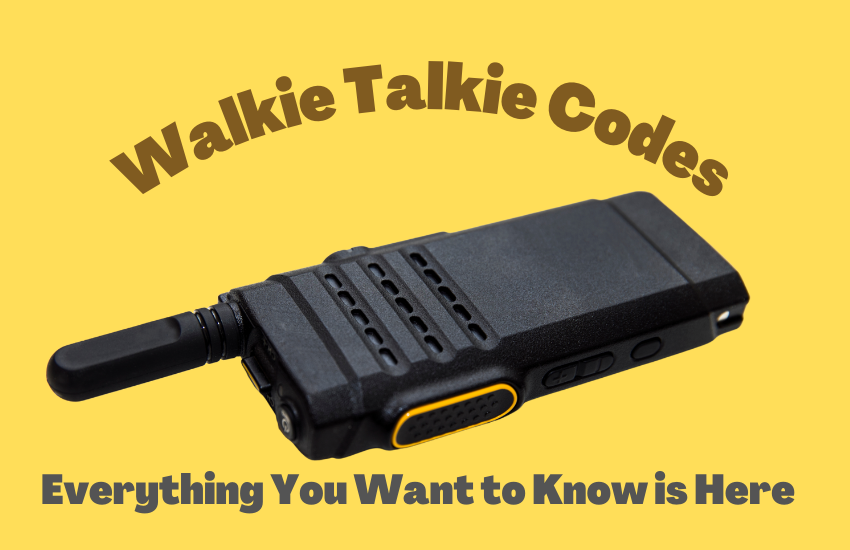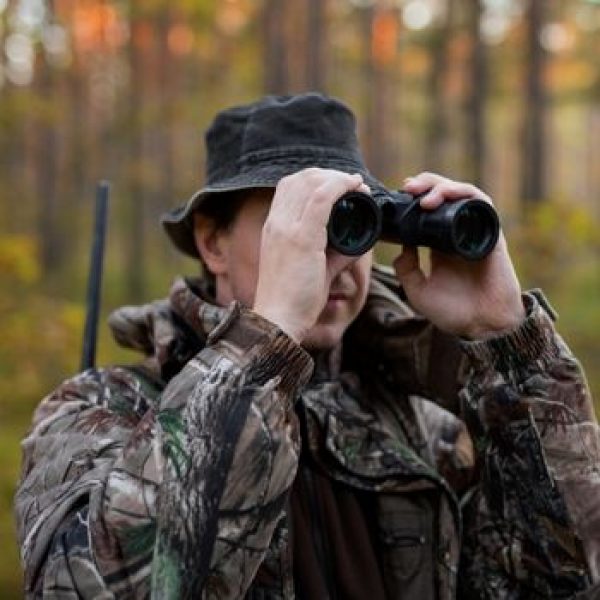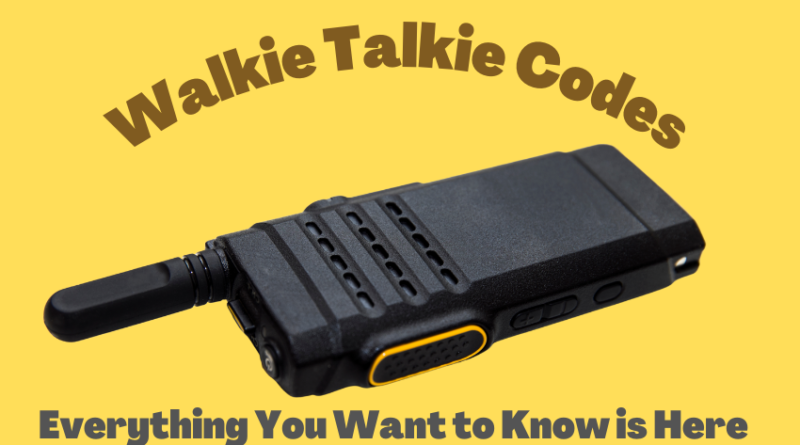Walkie Talkie Codes – Everything Is Here That You Want
Walkie Talkie Codes - Everything Is Here That You want
Walkie-talkies are an incredibly useful tool for communication and coordination, but the language used can be confusing. That’s why it’s important to understand walkie talkie codes – they will help you effectively communicate with others using your device.
Here, we’ll explain everything you need to know about walkie talkie codes so that you can use them confidently and efficiently. From common phrases to numeric codes, you’ll find all the information needed to make sure your conversations go smoothly every time.
Once upon a time, I was also a noob for walkie-talkie communication, but now with some practice and execution, I am now a pro at it. So you, too, can get a good idea of the code if you try.
If you’re ready to learn more about these essential tools for radio communication, read on!
Table of Contents
Walkie-Talkie Phrases :
For radio communication, the most common walkie-talkie phrases are:
– Roger – “I understand.” This is used to indicate that you have heard and understood a message.
– Over – “My turn to talk now.” This lets the other person know that you have finished speaking and that it is their turn.
– Out – “We’re done talking.” This tells the other person that the conversation is over.
– Wilco – “I will comply.” You would use this if someone has asked you to do something and you agree to do it.
– 10-4 – This is a less formal way of saying “I understand” or “message received.”

Numeric Walkie Talkie Codes :
In addition to the phrases mentioned above, there are also numeric codes that can be used when communicating via walkie-talkies. These include:
– 10-1 – “I don’t understand.” This lets the other person know that you didn’t catch their message.
– 10-2 – “Receiving loudly and clearly.” You would use this to let someone know that you heard them loud and clear.
– 10-3 – “Stop transmitting.” This tells the other person to stop talking.
– 10-7 – “I am now leaving the area.” You would use this to let someone know that you are leaving the area and will not be reachable via a walkie-talkie for a while.
By understanding the phrases and numeric codes used in walkie-talkie communication, you can make sure that your conversations are efficient and effective. With practice, you will be able to use them confidently.
What are Walkie Talkie Codes?
Walkie talkie codes are pre-determined words, phrases, or numbers used to communicate discreetly via radio transmission. Commonly referred to as ’10 codes’ due to their use of numerical combinations, walkie talkie codes can be easily customized for different groups and settings.
Some examples include:
10-1: Poor signal;
10-4: Message Received;
10-20: Location.
Learning the specific codes for your group or organization will ensure efficient communication and help keep messages secure.
10-Codes:
10-codes are shorthand phrases used by law enforcement officers to quickly and efficiently communicate information. These codes are broken down into numerical segments that represent certain words or phrases.
For example, 10-4 means “affirmative,” while 10-20 is “location.” 10 codes can also be used to describe crimes and situations succinctly.
It is important for law enforcement officers to be familiar with all of the codes they may encounter in order to ensure accurate communication in times of need.
11-Codes:
11 codes are similar to 10 codes but were created for emergency services personnel specifically. These codes are a set of phrases used to quickly and accurately communicate pertinent information about an incident or situation.
11-codes can range from describing the severity of an event (11-44, “Hazardous Materials Incident”) to requesting additional resources (11-99, “Emergency, All Units Respond”).
The use of 11 codes is helpful in allowing emergency personnel to quickly and clearly communicate information with accuracy and speed.
Signal Codes:
Signal codes are a set of coded messages used to communicate information quickly and securely. Signal codes use one- or two-word phrases that represent certain situations, such as “ASPB” (Alert and Secure Perimeter Base) or “CATU” (Clear and Take Under).
In addition to being used in military operations, Signal codes can also be useful for emergency responders, law enforcement agencies, and other organizations dealing with sensitive information.
By using these coded messages, users can securely communicate without fear of their messages being intercepted by unauthorized individuals.
Unit Designations:
Unit designations are used to identify specific responding units. For example, police officers would respond to an incident as “Unit 1,” firefighters as “Unit 2,” and paramedics as “Unit
3.” This helps ensure that all responders are aware of who is on the scene and can communicate effectively with each other.
Unit designations also provide a level of accountability, as responding personnel must answer to the designation assigned to them.
Using unit designations can help ensure that the correct personnel is responding in a timely manner, making operations run more efficiently while keeping everyone safe.
Radio Terminology:
Radio terminology is a set of terms used to communicate over two-way radio systems. Commonly used radio terms include: “10-4” (message received), “Roger” (message understood), “Over” (end of transmission), and “Out” (disconnecting from the call).
Additionally, specific codes may be used for emergency situations, such as “Code Red,” which signals all personnel to respond immediately.
Radio terminology provides a quick and efficient way for individuals to use two-way radios to communicate with each other in times of crisis or during routine operations.
Types of Walkie Talkie Codes:
Walkie talkie codes come in many forms and can range from short two-word combinations to longer sequences of numbers. Each type of Code serves a specific purpose, such as indicating the location, status, or importance of messages.
Commonly known types include Morse Code – a series of dots, dashes, and pauses; Plain Language – simple terms used by professionals; Prosigns – symbols that indicate pauses and space; Character Codes – a combination of letters and numbers.
Knowing the different types of walkie talkie codes is key to successful communication
How to Use Walkie Talkie Codes:
To effectively use walkie talkie codes, you must first understand their purpose. For instance, short numeric codes are often used to indicate status and location; Morse code is used for secrecy and security, and prosigns indicate pauses or spaces between words.
Once you understand the function of different codes, practice using them in conversations with your peers.
Additionally, be sure to familiarize yourself with any specific codes used by your team or organization to ensure clear and efficient communication.
Walkie-talkie Code Examples:
Common examples of walkie talkie codes include ’10-4′ for acknowledgment, ‘What’s your 20?’ for whereabouts, and ‘Baker 5’ for personnel.
Additionally, Morse code is often used over walkie-talkies to communicate messages quickly and securely. Prosigns such as BT (break), AR (end), and SK (silent key) are combined to indicate pauses or gaps in the conversation.
Character codes are also used, with commonly known combinations such as 77 for “best regards” and 73 for “best wishes.” Understanding these specific codes will help ensure smooth communication via walkie-talkies.
Common Walkie-Talkie Emergencies and How to Handle Them:
When it comes to common walkie-talkie emergencies, timing is of the utmost importance. If you encounter a life-threatening situation, use an emergency code such as ‘help me’ or ‘I need help’ to alert your team.
Additionally, be sure to give your approximate location and provide as many details as possible regarding the emergency. Other common emergencies include signaling for a lost person, damaged equipment, or depleted supplies; in these cases, explicitly state what you need and how quickly it must be provided.
Lastly, remember that clear communication over the walkie-talkie is key in order to managing any emergency efficiently and effectively. Thank God once I was in danger and successfully overcome due to proper use of a Walkie-Talkie emergency.
So I think it is very important to know about the emergency use of walkie-talkies Because we never know what will happen to us.
What are Some of The Most Common Walkie Talkie Codes:
Walkie-talkies are often used with codes to help with communication. Some of the most common codes include ’10-4′ for acknowledgment, ‘Roger’ for confirmation, ‘What’s your 20?’ for whereabouts, and ‘Baker 5’ for personnel.
Additionally, Morse code is often used over walkie-talkies in order to quickly and securely communicate messages. Prosigns such as BT (break), AR (end), and SK (silent key) are combined to indicate pauses or gaps in the conversation.
Character codes such as 77 for “best regards” and 73 for “best wishes” can also be added when needed. Understanding these specific codes will help ensure a smooth transition while using walkie-talkies.
How can You Create Your Own Custom Walkie Talkie Codes:
Creating your own custom walkie talkie codes is a great way to enhance communication with your team and your friend and also with your special someone.
To start, make sure you have a good understanding of the basic codes used by your walkie-talkie before designing a new code. From there, decide on an appropriate phrase and assign an alternate word or phrase to represent it.
Additionally, use abbreviations whenever possible to simplify the Code and help it become easy to remember. Once you create the Code, write it down and practice using it with your team so they can become familiar with its meaning. With that, you will have successfully created a new walkie talkie code for your team’s use!
What are Privacy Codes on Walkie Talkies and Why do They Exist:
What is a privacy code on a walkie-talkie? Well, Privacy codes on walkie-talkies are designed to ensure that only the intended parties are receiving and understanding the messages being transmitted.
These codes help restrict access to confidential information as well as eliminate interference from other radio users. They also provide an added layer of encryption which makes it harder for any unauthorized individuals to eavesdrop on the conversations taking place.
Privacy codes are essential in order to protect sensitive conversations and prevent the transmission of confidential information from falling into the wrong hands.
How to Change the Privacy Code on Your Walkie-Talkie:
Changing the privacy code on your walkie-talkie is fairly simple. First, ensure that you have all of the settings for your radio correct. Next, locate the keypad lock/unlock switch and hold it down as you type in a new privacy code.
It’s important to remember this Code so that you can use it whenever you need to access the secure channels available on your radio. Once the Code is entered and confirmed, you are ready to use it with other radios that share the same frequency and privacy code.
Having a unique security code helps keep conversations private and secure!
The Benefits of Using a Privacy Code on Your Walkie-Talkie:
The use of a privacy code on your walkie-talkie provides numerous benefits. By using a secure code, you can ensure that only the intended parties have access to the conversations being transmitted and that unauthorized individuals cannot eavesdrop.
Additionally, the added layer of encryption helps protect confidential information from prying eyes. Using a privacy code also eliminates interference from other radio users, making it easier to stay in communication with one another while maintaining privacy.
With these benefits, it’s easy to see why having a privacy code is so important when using walkie-talkies.
Tips for Setting up Your Privacy Code Correctly:
When setting up your privacy code, it’s important to take a few key steps to ensure that the process goes smoothly. First, make sure that you follow the manufacturer’s instructions when creating your Code.
Secondly, use caution when entering the Code and double-check your entry for accuracy. Additionally, store the Code in an easily accessible location so that you can easily reference it if you ever need to deactivate or change it in the future.
Finally, using a strong and unique password helps protect your private conversations from potential eavesdroppers. Following these tips will help ensure that you have a secure and reliable privacy code on your walkie-talkie.
Examples of When You Might Need to Use a Privacy Code On Your Walkie talkie:
There are many situations when using a privacy code on your walkie-talkie can be beneficial. For instance, if you work in an environment where sensitive information is exchanged, such as a hospital or police station, it’s important to have secure communication that can’t be listened in on.
Additionally, individuals who participate in outdoor activities like camping may need a privacy code to keep their conversations private from any potential eavesdroppers.
Finally, businesses may also need to use a privacy code if they’re passing confidential data between offices. In these cases and more, having a secure privacy code helps keep your communication private and safe.
What are Police Walkie Talkie Codes, and What Do They Mean?
Police walkie talkie codes are a series of numbers and letters used to identify a particular radio frequency. These codes are used by police officers in both the United States and Canada as a way for them to communicate with each other without broadcasting their messages to the public.
Examples of codes include 10-4, meaning “OK,” or 10-100, which means “break the law.” Understanding these codes can help civilians better understand what is happening when they hear police radios in action.
Police Walkie Talkie Codes:
Police walkie talkie codes are a great way to quickly access and communicate important information. Each police department chooses its own code names to represent different areas or situations.
The most common codes include 10 codes, which have universal definitions such as “10-4,” meaning “OK,” or “10-8,” meaning “back in service.” Other specialized codes exist for criminals, vehicles, and even the time of day.
Knowing these walkie talkie codes can help ensure efficient communication during emergency situations.
How Can Civilians Use Police Walkie Talkie Codes to Their Advantage When Interacting With Law Enforcement Officers?
Knowing police walkie talkie codes can be a helpful tool when interacting with law enforcement officers.
For instance, if an officer is communicating on the radio about an incident and mentions a code like “10-4,” civilians can better understand what is happening by recognizing that 10-4 means “OK.” Similarly, people may also recognize codes such as “10-20,” meaning “location,” or “10-59” as meaning “assist other units.” Knowing these codes can help civilians make more informed decisions in difficult situations, leading to better outcomes for everyone involved.
Are There Any Specific Police Walkie Talkie Codes that Should be Avoided by Civilians Altogether Due to Their Potentially Dangerous Nature?
Yes, there are certain codes that civilians should be aware of and avoid using due to their potentially dangerous nature.
For example, 10-90 means “attempted suicide,” 10-91 is a call for fire department assistance with an arson investigation, and 10-10 signifies an officer in need of immediate assistance.
Civilians should never use these codes as they can alert law enforcement officers to potential danger or hazard.
How Can You Use Police Walkie Talkie Codes to Improve:
Knowing police walkie talkie codes can be a useful tool to improve safety and efficiency when interacting with law enforcement officers. By understanding the most commonly used codes, you can communicate more effectively and respond faster to requests made by officers.
Additionally, civilians should also be aware of the dangerous codes, which should never be used in order to ensure that no one is put at risk due to misuse of the language.
Knowing these codes can help civilians stay safe and informed in potentially hazardous situations.
Examples of Real-Life Police Code Words and What They Mean:
Police code words and phrases can vary from region to region, but there are some common examples that many law enforcement agencies use.
For example, 10-4 is commonly used to mean “affirmative” or an agreement between two officers, 10-20 means “location” or the place where someone is located, and 10-33 indicates an emergency with imminent danger.
Additionally, certain words may have a particular meaning for police, such as “Adam,” which means car, and “George,” which means suspect. Understanding these codes can help civilians better understand police radio chatter and the activities of law enforcement officers in their area.
The Different Types of Codes Used by Law Enforcement:
Law enforcement agencies use a variety of codes to communicate with each other quickly and efficiently. These include plain language codes, which are usually used for general communication, 10 codes, which are used to describe crimes or situations more succinctly; and signal codes, which are used to indicate the severity of an emergency.
Additionally, some law enforcement agencies may use customized codes specific to their region or organization. It is important for law enforcement officers to be familiar with all of the codes they may encounter in order to ensure accurate communication in times of need.
How to Decipher Police Code Language:
Decoding police code language can be a daunting task for those without experience. However, with some knowledge of the terminology and language used, it is possible to decipher many common codes.
It is important to be familiar with the most popular codes, such as 10 codes, plain language codes, and signal codes, as well as any customized codes used by local agencies or organizations.
Additionally, listening to radio transmissions in real time can help one become familiar with what certain codes mean in practice. With enough practice, it is possible to become proficient in understanding police code language.
What Happens If You Don't Know the Code For a Particular Situation and Need to Ask for Help Over the Radio?"
If you don’t know the Code for a specific situation and need to ask for help over the radio, it is important that you remain calm and give clear instructions. Tell the officers the nature of your request, your current location, and any other relevant information.
Speak slowly and clearly to ensure that all information is heard correctly. If possible, provide a brief description of yourself or any situation that could indicate to officers that help is needed. This will help them respond quickly and correctly in order to keep everyone safe.
Some of The Advantages of Using Walkie-Talkies For Communication:
Walkie-talkies are reliable and effective tools for communication in many situations. They allow for near-instantaneous communication between two or more people, making them ideal for coordinating teams in a short amount of time.
Additionally, their portability and durability allow them to be used in areas where other communication tools might not work as well. They are also relatively inexpensive, which allows organizations to stay connected without breaking the bank.
Finally, they provide secure communications with minimal interference, making them a preferred choice for those looking to maintain confidentiality.
How to Talk in Walkie Talkie Codes:
Talking in walkie talkie codes is fairly straightforward, but it does involve some specific terminology. Before using a walkie-talkie, familiarize yourself with the keywords and phrases used for communication, such as: “10-4” (message received), “Roger” (message understood), “Over” (end of transmission), and “Out” (disconnecting from the call).
Additionally, be aware of any special codes that may be applicable to your environment and situation. With these basic terms and concepts in hand, you’ll be ready to communicate effectively over two-way radios.
How to Use Morse Code on a Walkie-Talkie:
Using morse code on walkie-talkies is a great way to send short messages quickly and efficiently. Basically, I use this type of code very because, in daily life, we use much and more short messages.
To do this, first learn the basic elements of morse code, such as dots (short tones) and dashes (long tones). Then practice sending and receiving individual letters until you have a good understanding of how to translate dot/dash sequences into letter combinations.
Finally, begin to group together letter sequences into words and phrases until you are comfortable sending entire messages without having to look up codes or characters. With a bit of practice and execution, you will be able to communicate clearly using morse code over two-way radios.
Code Names for Walkie Talkie:
Using code names for walkie-talkies is a great way to keep communications secure and private. Whenever possible, use unique, one-time code names that are not easily guessed.
Additionally, you should change these code names frequently to ensure extra security. Code names can be anything from random words or phrases to more complex alphanumeric sequences.
However, make sure everyone involved in the communication knows the current code name prior to transmission so that messages can be received and understood without confusion or delays.
Final Word:
Walkie talkie codes are an efficient way to communicate over two-way radios. By understanding and using the proper radio terms, radio users can quickly and easily communicate with one another in both emergency and routine situations.
With this knowledge, you will be well-equipped to use walkie-talkies effectively and safely in any situation.
If you are interested in buying a walkie-Talkie then you can check out our best walkie-Talkies.

Jack Brown
My Self Jack Brown. I’m experienced hunter and camper. I have been hunting for over 20 years, and camping for even longer, and have spent countless days and nights in the great outdoors. I’m an expert in wilderness survival and has honed his skills through years of experience in the field. I’m also an accomplished writer, and his writing reflects his love for hunting and camping. I have written several articles, essays and even a book about my experiences in the wild, and my work has been featured in various outdoor and hunting magazines.





Thanks for a marvelous posting! I actually enjoyed reading it, you may be a great author.
I will make sure to bookmark your blog and will come back later in life.
I want to encourage that you continue your great work, have a
nice evening!
Thanks for your comment..